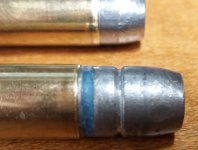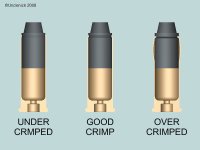disseminator
New member
Hey guys,
So I had a bullet jump the crimp in my 460 magnum and thought I'd share:
These are Doubletap 400 grain WFNGC bullets and I am working up loads to about 1650 fps or so.
The recoil is stout. I have heard of jumping the crimp but this is a first for me. The bullets are HEAVILY (.008") crimped. So much so I was worried I was deforming the bullet. I am using Starline Brass and LilGun with CCI Large Rifle Magnum primers.

Sorry it's a little foggy, camera is wack. You get the gist of it. It DID stop the cylinder from rotating but I was able to swing it open and remove the round. It came out just as pictured.
So I had a bullet jump the crimp in my 460 magnum and thought I'd share:
These are Doubletap 400 grain WFNGC bullets and I am working up loads to about 1650 fps or so.
The recoil is stout. I have heard of jumping the crimp but this is a first for me. The bullets are HEAVILY (.008") crimped. So much so I was worried I was deforming the bullet. I am using Starline Brass and LilGun with CCI Large Rifle Magnum primers.
Sorry it's a little foggy, camera is wack. You get the gist of it. It DID stop the cylinder from rotating but I was able to swing it open and remove the round. It came out just as pictured.


